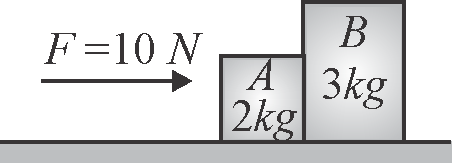363141
A horizontal force \(F\) pushes on \(4\;kg\) block \((A)\) which pushes against a \(2\;kg\) block \((B)\) a shown. The blocks have an acceleration of \(3\;m{\rm{/}}{s^2}\) to the right. There is no friction between the blocks and the surfaces on which they slide. What is the net force \(B\) exerts on \(A\) ?
363141
A horizontal force \(F\) pushes on \(4\;kg\) block \((A)\) which pushes against a \(2\;kg\) block \((B)\) a shown. The blocks have an acceleration of \(3\;m{\rm{/}}{s^2}\) to the right. There is no friction between the blocks and the surfaces on which they slide. What is the net force \(B\) exerts on \(A\) ?
363141
A horizontal force \(F\) pushes on \(4\;kg\) block \((A)\) which pushes against a \(2\;kg\) block \((B)\) a shown. The blocks have an acceleration of \(3\;m{\rm{/}}{s^2}\) to the right. There is no friction between the blocks and the surfaces on which they slide. What is the net force \(B\) exerts on \(A\) ?
363141
A horizontal force \(F\) pushes on \(4\;kg\) block \((A)\) which pushes against a \(2\;kg\) block \((B)\) a shown. The blocks have an acceleration of \(3\;m{\rm{/}}{s^2}\) to the right. There is no friction between the blocks and the surfaces on which they slide. What is the net force \(B\) exerts on \(A\) ?
363141
A horizontal force \(F\) pushes on \(4\;kg\) block \((A)\) which pushes against a \(2\;kg\) block \((B)\) a shown. The blocks have an acceleration of \(3\;m{\rm{/}}{s^2}\) to the right. There is no friction between the blocks and the surfaces on which they slide. What is the net force \(B\) exerts on \(A\) ?






